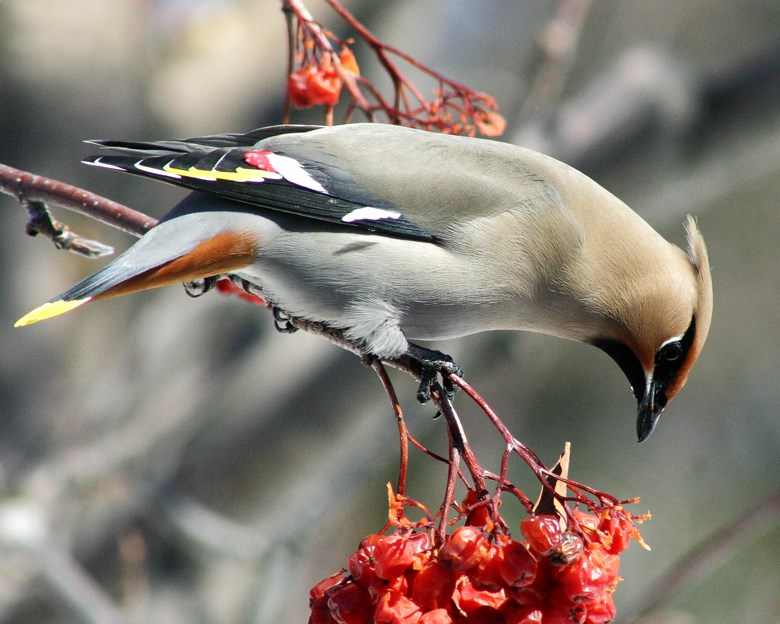With such a wonderful, long extended fall, the coming winter seems almost illusionary. But it’s no doubt on its way. Gardeners with trees or shrubs that retain their fruit through the long prairie winter have a wonderful opportunity not only to enjoy the often bright red splash of the fruits’ colour against the snow but to also enjoy the over-wintering birds who come to feast on them.
Following are some of the hardy, fruit-bearing trees that can provide a mini smorgasbord for wintering birds. Consider adding these to your landscape this spring.
Showy mountain ash (Sorbus decora)
Although several species of mountain ash will survive prairie winters, the best choice in terms of hardiness and disease resistance is the showy mountain ash, native to Manitoba. A tree long associated with magic, sorbus means stop, possibly a reference to warding off witchcraft. The species name, decora, means decorated or showy.
It is indeed showy, with four-season landscape value: flat clusters of showy white flowers in the spring; orange-red fruit in summer that persist through winter; and brilliant red fall foliage. And a size (an oval to rounded form about 20 ft / 6 m in height) that makes it suitable for both small and expansive landscapes.
The fruit persists through winter (until consumed by flocks of waxwings), offering a sharp contrast to our otherwise white landscape.
Plant mountain ash in full sun on well-drained soil. Water until established after which it is very drought-tolerant.
Amur or ginnala maple (Acer ginnala)
Here is a small, tough tree of about 15 ft (4.5 m) with amazing fall colour, varying from yellow to orange to red to brilliant scarlet. It is native to China, Siberia, Japan and Manchuria including the Amur River Valley from which it gets its common name. The paired winged seed pods, known as samaras, are a brilliant red, ripening to a straw colour. The seeds, retained through winter, are a treat for grosbeaks and other birds. Among the improved varieties are: ‘Atomic’, ‘Bailey’s Compact’, Durone’, ‘Flame’ and ‘Royal Crown.’
Plant them in well-drained soil in full sunlight. It is excellent for smaller urban yards or massed in larger spaces.
Flowering crabapple (Malus spp.)
We usually think of flowering crabapples in terms of their lovely white to pinkish-red spring bloom. Small, dense, low-headed trees of up to 25 ft (7.5 m), are ideally suited to smaller urban landscapes or planted as groupings in larger rural settings. Relatively fast growing, their lifespan is about forty years or more. Plant them in full sunlight on well-drained soil. Among those with fruit that is retained through the winter until consumed by birds are:
- ‘Rudoph’ is a symmetrical upright tree of about 12 ft (3.5 m) with red flowers, bronze foliage and persistent red fruit.
- ‘Pink Spires’ has pink flowers and a narrow columnar form of 20 ft (6 m). The purple-red leaves turn a greenish-bronze and become orange-yellow in the fall. The dark red fruit persists over the winter.
- ‘Kelsey’ is an upright, rounded tree to 18 ft (5.5 m) with double pink flowers in the spring, bronzy-green foliage which becomes orangish-yellow in the fall, and small purple fruit that persists into winter.
- ‘Makamik’ has an upright rounded form of about 20 ft (6 m), reddish-purple spring bloom, and dark purple leaves (turning orange in the fall). The small dark red fruit persists through the winter.
- ‘Prairiefire’ has rich pink flowers in the spring, purple leaves, and dark purple-red fruit that persists through winter. It has a height and spread of 15-20 ft (4.5-6 m).
- ‘Radiant’ is compact, symmetrical and rounded, with a height and spread of about 15 ft (4.5 m). Single pink flowers are followed by bright red persistent fruit.
- ‘Red Splendor’ has a large open form with a height and spread of 15 ft (4.5 m). It has deep rose-pink flowers, green foliage and retained red fruit.
- ‘Selkirk’ is vase-shaped, with a 20 ft (6 m) height and spread, with burgundy spring foliage. Single pink flowers are followed by persistent red fruit.
- ‘Starlite’ has a height of 25 ft (7.5 m) and a spread of 15 ft (4.5 m). A profusion of white spring flowers is followed by tiny red fruit which are retained through winter.
Sara Williams is the author of many books including Gardening Naturally with Hugh Skinner, Creating the Prairie Xeriscape, and with Bob Bors, Growing Fruit in Northern Gardens. She gives workshops on a wide range of gardening topics throughout the prairies.
This column is provided courtesy of the Saskatchewan Perennial Society (SPS; [email protected]). Check our website (www.saskperennial.ca) or Facebook page (www.facebook.com/saskperennial) for a list of upcoming gardening events.
Bookmark SASKTODAY.ca, Saskatchewan's home page, at this link.




